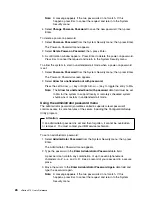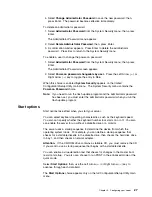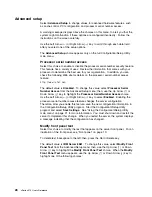
Chapter 4. Installing options
This chapter provides instructions to help you add options to your server. Some
option-removal instructions are provided, in case you need to remove one option to
install another.
Before you begin
Before you install any optional hardware in your server, thoroughly review the
information in this section. Also, review the power supply requirements described
in “Replacing a hot-swap power supply” on page 84.
Become familiar with the safety and handling guidelines specified under “Safety
information” on page 39 through “Handling static-sensitive devices” on page 43
and “Working inside a server with power on” on page 44.
If you upgrade your server by installing a RAID adapter, you must configure
your disk arrays after you install hard disk drives, as described in “Installing
internal drives” on page 79. Follow the instructions in the RAID adapter
documentation after installing the drives. Then, return here to install your
remaining options, if applicable. See Chapter 3, “Configuring your server” on
page 19 for additional details about configuration and for a description of your
server utility programs.
You do not need to turn off the server to install or replace hot-swap power
supplies, hot-swap fans, hot-swap drives, or hot-plug PCI adapters.
–
Hot-swap
means that you can install or remove certain components, such
as power supplies, fans, and hard disk drives, without turning off the server,
provided that your server contains hardware and an operating system that
support the installation or removal of these components. These
components are known as
hot-swappable
components, and more
commonly referred to as
hot-swap
components.
–
Hot-plug
means that you can install or remove certain components without
turning off the server, after you perform an intervening action, provided that
your server contains hardware and an operating system that support the
installation or removal of these components. For example, before you can
install or remove hot-plug PCI adapters, you must enable or disable the
hot-plug PCI slots that contain or will contain these adapters. To do this,
you must perform your operating-system-defined procedures for enabling or
disabling the affected hot-plug PCI slots. Failure to do so might cause your
system to lock up. Refer to your operating-system documentation for
additional information.
Hot-plug
components are also known as
hot-pluggable
components.
The orange color on components and labels in your server indicates hot-swap
or hot-plug components. This means that you can install or remove the
component while the system is running, provided that your system is configured
to support this function. For complete details about installing or removing a
hot-swap or hot-plug component, see the information provided in this chapter.
The blue color on components or labels indicates touch points where a
component can be gripped, a latch moved, and so on.
Copyright IBM Corp. 2001
37
Summary of Contents for eServer 370 xSeries
Page 1: ...User s Reference xSeries 370...
Page 2: ......
Page 3: ...IBM xSeries 370 User s Reference...
Page 32: ...16 xSeries 370 User s Reference...
Page 188: ...172 xSeries 370 User s Reference...






























